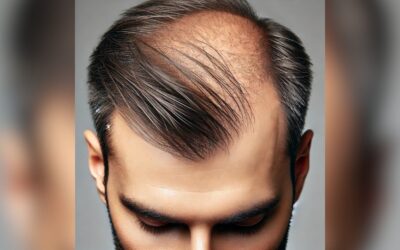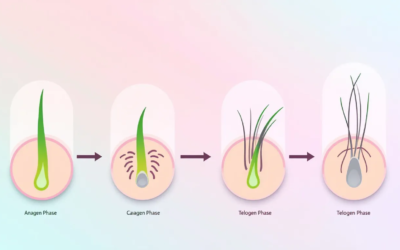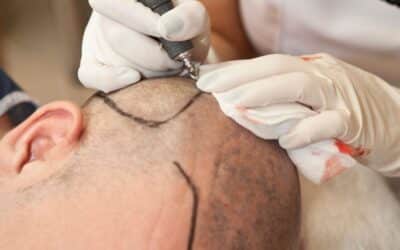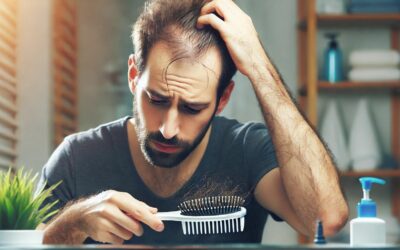What Is Hair Shock Loss?
Shock loss after hair transplant surgery is a normal occurrence in which the newly transplanted hair is shed. This mass shedding is normal and usually starts a few weeks after surgery. Within 8-12 months your new hair will grow in its place. There are different types of shedding to be aware of after transplant surgery. In this article, we will discuss which type of shedding is normal to experience after hair transplant surgery.
Follicular Shedding & Shock Loss After Hair Transplant Surgery
Shedding of the transplanted hair is almost certain in the days and weeks following surgery. It is necessary in order for the transplanted follicles to regenerate and create new hair growth in the long term. So even though it is normal to experience anxiety initially, as long as you are following your surgeon’s instructions about post-operative care best practices, your new hair will grow in no time. As much as 90 percent of the transported grafts may shed hair in the first month after surgery. When the hairs are shed, you may see that there is a crust at the top of the head and a bulb at the bottom. Do not be alarmed, it does not mean that there has been any damage to the follicle.
The transplanted follicles are safe beneath the surface of the scalp. It is normal to see some scabbing and redness in the recipient area, there will also be some scabbing at the donor sites where the grafts were harvested. In about a week’s time, the scabs will begin to fall away from the donor area, and it may take a little longer, about a week and a half for the scabs to fall away at the recipient area. At this stage, it is essential that you follow the proper after-care instructions that your doctor gives you.
These measures will minimize any pain or discomfort you experience after surgery, and will also eliminate your risk of infection. You will be advised to refrain from smoking, exposing your scalp to direct sunlight, swimming, exercising, or wearing things like hats, wigs, or helmets for the first few weeks after surgery. At your post-operative evaluation, your doctor will advise you on the best hair care practices for the future.
Experiencing Bleeding Shock Loss After Hair Transplant Surgery
If you experience bleeding at the time of shedding, call your doctor immediately. While this is a rare occurrence, it could be a sign that the graft was not adequately transplanted. Improperly placed follicles usually happen as a result of working with an inexperienced surgeon.
At Best Hair Transplant our team has over 16 years of experience, and our surgeons are highly trained by the best institutions in their field. We have never had this happen at our clinic in that time. However, not everyone is lucky enough to choose a quality hair transplant clinic. Those traveling out of the country are more likely to experience bleeding shock loss after hair transplant surgery.
Changes In Color & Texture After Hair Restoration Procedures
There is no need to be alarmed if you notice that your newly transplanted hair is a lighter color, or appears finer when it first begins to emerge. Over the course of the next year, your hair will take on a thicker tone, and the hair will begin to darken as the new hair grows out.
Incorporating low-level laser therapy (LLLT) with a laser cap such as the CapillusRX can be a great way to encourage the new growth to thrive. The CapillusRX has been shown to reduce shedding, increase hair density, and boost the production of melanin which is what is responsible for the pigment that darkens the shade of your hair.
Some patients also choose to incorporate Minoxidil into their routine to encourage their transplant to grow out. This can also be a good long-term measure to protect against excessive shedding in the future.
Other Events That Trigger Shock Loss
In some rare cases, patients will suddenly lose hair from both the recipient and donor area about 4 to 8 weeks after surgery. This type of loss can occur after many different types of life events that put stress on the body, including surgery. It is not just limited to hair transplant surgery. While this can be distressing, it is only a temporary condition and if this happens, the hair will grow back.
There tends to be less incidence of this type of lock loss after Follicular Unit Extraction (FUE) than there is Follicular Unit Transplantation (FUT). This could be because FUE is less invasive and does not require any suturing. Women tend to be slightly more susceptible to this phenomenon than men. Incorporating nutrition, supplements, and healthy stress management habits that support your body’s ability to handle stress will help to prevent this type of shedding. If you have any concerns about this, discuss them with your doctor during your consultation.
Shedding and shock loss after hair transplant surgery can be very worrisome if you are not prepared. Hair restoration is a process that takes a lot of time, patience, and consistency. Your doctor will be able to help you decide on a course of treatment that will help you reach your desired result. They will also be able to prepare you for each phase of the hair restoration process, from surgery to recovery and beyond.
SUFFERING FROM HAIR LOSS?
Best Hair Transplant is the best place to schedule your hair transplant in Los Angeles. We’ve helped both men and women regrow their lost hair. But don’t take our word for it. We suggest learning as much as possible about hair restoration. Do so prior to making a decision on how to address your hair loss. Not every procedure is right for everyone.
At Best Hair Transplant, we’re proud of our results and happy to provide hair restoration services. Additionally, we’re proud to make hair transplants affordable and help you save money on a variety of hair transplants.
To ensure your ease of mind, you can view our customer recommendations HERE. Furthermore, you can also see our Google reviews and Yelp reviews. We can’t wait to help you start restoring your lost hair.
YOUR HAIR RESTORATION SOLUTION
Best Hair Transplant
1970 S. Prospect Ave., Suite 2
Redondo Beach, CA 90277
(213) 403-0455










